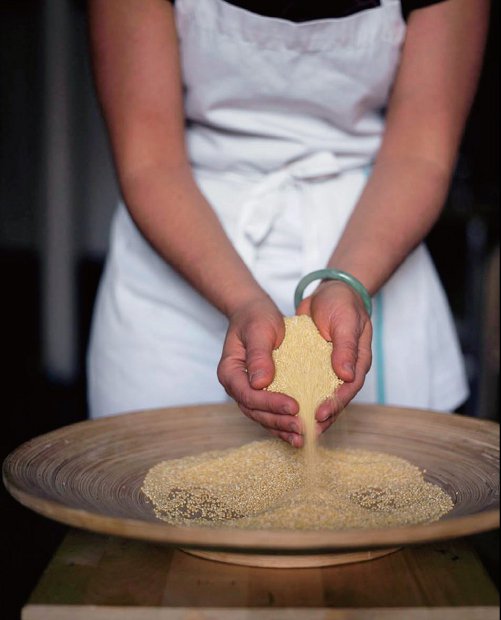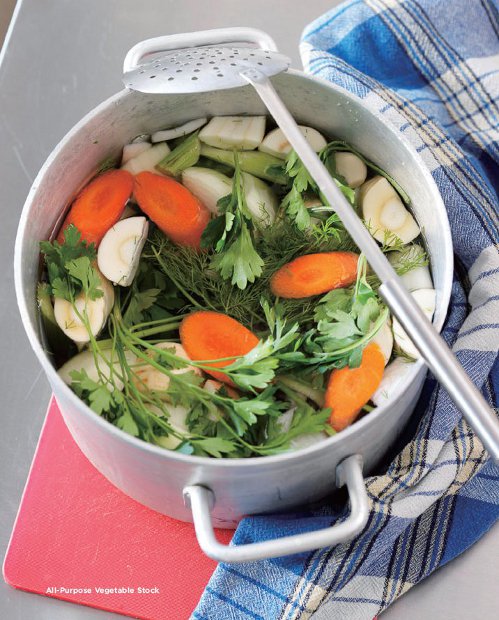
BASIC RECIPES
This should be the most dog-eared section in the book. These basic recipes are multipurpose, and I refer to them throughout the rest of the book. Some of the recipes can be made in advance or in bulk and kept in the refrigerator or the freezer as directed so they are ready when you need them. Basics that require refrigeration have a shelf life of 3 to 4 days for optimal freshness.
We’re going back to a place of empowerment, where we consciously decide what goes into our bodies. We needn’t be at the mercy of large-scale manufacturers and mass-produced packaged products. We can restore body and soul to a harmonious state of purity and simplicity. We can reconnect with our food. When we prepare our meals from scratch, it’s impossible to eat mindlessly; we appreciate every ingredient, every source, every cleansing bite. These basic recipes nourish us on a much deeper level, by offering more nuanced flavor with less salt and fat and leaving us more satisfied.
—NATALIA
All-Purpose Vegetable Stock
I never plan on making a stock; it just happens when I’ve accumulated enough vegetable trimmings. But I always start with carrot, celery, onion, garlic, tender herbs, and bay leaves. I will toss in corncobs, parsnip, parsley stems, mushroom stems, fennel, and asparagus if I have them, but I don’t go out of my way to get them if I don’t. Just avoid any cruciferous vegetables such as cabbage, broccoli, or kale, which will dominate the stock with a strong off-putting flavor. Also, avoid strong herbs such as sage, rosemary, or too much marjoram. If you sauté the aromatics beforehand, especially mushrooms and stems, the stock will be richer and more robust and better suited for heartier recipes.
1 large white or yellow onion, quartered
2 medium carrots, roughly chopped
2 celery stalks, roughly chopped
5 garlic cloves
2 bay leaves
Handful of herbs (parsley, dill, thyme, chives, oregano, etc.)
4 cups any vegetable trimmings (parsnip, corncobs, zucchini, tomatoes, mushrooms, scallions, etc.)
3 quarts water
Toss all ingredients in a large stockpot and cover with water. Bring to a boil, then simmer for 1 hour, until vegetables are soft. Strain through a sieve (pressing the vegetables down will extract more liquid and flavor but may muddy the stock). Refrigerate and use for up to 3 or 4 days, or freeze in a sealed container for longer storage.
MAKES APPROXIMATELY 2 QUARTS
Mushroom Gravy
Please note that the arrowroot powder in this recipe loses it thickening properties when overcooked, so if you need to reheat the gravy, just let it come to a bare simmer.
½ cup chopped onions
2 garlic cloves, minced
1 pat butter or 1 tablespoon olive oil
1 cup diced cremini, portobello, or shiitake mushrooms
1 tablespoon fresh thyme leaves
1 large bay leaf
2 cups vegetable stock
2 tablespoons arrowroot powder
In a large saucepan, sauté the onions and garlic in butter or oil until the onions are soft (about 8 minutes).
Add the mushrooms and herbs and continue sautéing, adding 1 tablespoon of water as needed to keep the aromatics from drying out without having to add more oil. When the mushrooms are soft, add the vegetable stock and simmer.
Meanwhile, mix the arrowroot powder with a little cold water (about 2 tablespoons) to form a slurry. Stir the arrowroot slurry into the simmering stock for 30 seconds until blended.
Transfer the gravy to a food processor and puree until smooth.
MAKES 3 CUPS
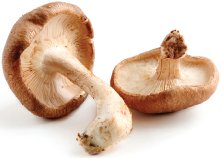
TOMATO-BASED SAUCES
These three basic but diverse tomato-based sauces make last-minute meals a breeze. They also freeze well, so make a big batch of each and portion out the sauces into pint-size freezer bags, flattening them out in an even layer so they can be easily defrosted in warm water when needed.
These three sauces are made using the same basic ingredients and method, but they are changed significantly by the unique flavors and herbs that make them special. Be sure to try all three.
—NATALIA
Basic Tomato Sauce
Adding carrots sweetens the sauce, so you can skip the sugar that is found in most tomato sauce recipes. If you don’t like the mouthfeel of diced carrot and prefer a smoother texture, you can grate the carrot instead of dicing it. I prefer a chunkier, more rustic texture.
2 tablespoons extra-virgin olive oil
4 garlic cloves, minced
Pinch of crushed red pepper (optional)
1 medium yellow onion, diced
1 medium carrot, diced
1 (28-ounce) can peeled whole tomatoes
1 tablespoon dried oregano
2 bay leaves
Salt and pepper to taste
Heat the oil in a large saucepan. Add the garlic and the crushed red pepper and sauté for 1 minute until the oil is fragrant.
Add the onion and carrot and cook until the vegetables are soft (about 8 minutes).
Add the tomatoes and dried herbs and bring to a boil, stirring often. Lower the heat and simmer for 20 minutes.
Break up the tomatoes with a fork or masher and simmer for an additional 10 minutes. Season with salt and pepper as desired.
MAKES 1 QUART
Spanish Tomato Sofrito Sauce
This piquant sauce is a wonderful base for stews and tapas-style dishes, a pan sauce for fish, and an accompaniment for grains or beans.
2 tablespoons extra-virgin olive oil
6 garlic cloves, minced
1 medium yellow onion, diced
2 green bell peppers, cored, seeded, and diced
1 jalapeño, seeded and finely diced
1 bunch cilantro, chopped
1 (28-ounce) can crushed tomatoes
1 tablespoon dried oregano
2 bay leaves
1 tablespoon ground coriander
1 tablespoon ground cumin
1 teaspoon cayenne pepper
Salt and pepper to taste
Heat the oil in a large saucepan. Add the garlic and sauté for 1 minute until the oil is fragrant.
Add the onion, green bell peppers, jalapeño, and cilantro and cook until the vegetables are soft (about 8 minutes).
Add the tomatoes, dried herbs, and spices and bring to a boil, stirring often. Lower the heat and simmer for 30 minutes. Season with salt and pepper as desired.
MAKES 1 QUART
Spicy Matbucha Sauce
This Moroccan-inspired recipe is the most versatile tomato-based sauce. It is a perfect base for vegetables, seafood, eggs, tagines, stews, and even pizza.
2 tablespoons extra-virgin olive oil
4 garlic cloves, minced
1 medium yellow onion, diced
2 red bell peppers, cored, seeded, and diced
1 jalapeño, seeded and finely diced
1 (28-ounce) can crushed tomatoes
1 tablespoon dried oregano
2 bay leaves
1 tablespoon cayenne pepper
Salt and pepper to taste
Heat the oil in a large saucepan. Add the garlic and sauté for 1 minute until oil is fragrant.
Add the onion, red bell peppers, and jalapeño and cook until the vegetables are soft (about 8 minutes).
Add the tomatoes, dried herbs, and spices and bring to a boil, stirring often. Lower the heat and simmer for 20 minutes.
Season with salt and pepper as desired.
MAKES 1 QUART
Quick Ketchup
This is a super-quick recipe, tangy and sweet, without added sugar. It makes a great tomato glaze for vegetable loaves (see Mushroom Loaf, page 168).
1 cup chopped tomatoes (vine ripe, plum, or cherry)
½ cup soaked sundried tomatoes, or 2 tablespoons tomato paste
2 tablespoons apple cider vinegar
1 garlic clove
Stevia to taste
Put all the ingredients in a high-speed blender and blend to a smooth consistency.
MAKES 1½ CUPS
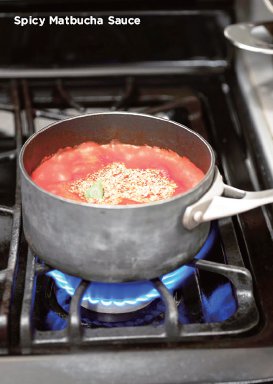
BASIC GRAINS, PASTAS & PLANT-BASED ALTERNATIVES
This section is bound to raise eyebrows. My credibility as a chef is being questioned at this very moment, but let’s talk this through. Most forms of rice, pastas, and breads not only are overly processed and stripped of their nutrients, but are also high glycemic carbohydrates that wreak havoc in your body. High-quality grains such as millet, buckwheat, and quinoa are better options and definitely have a place in your diet as long as you eat them in moderation. But plant-based foods are the kings and queens in the hierarchy of foods. Most of the following recipes are neutral (made of low-starch vegetables) so you can enjoy pasta with protein or pizza with cheese. That in itself should motivate even the most novice detoxer to give these recipes a try.
These dishes never fail to amaze. They are hearty and offer all the satisfaction and comfort of a bowl of rice or pasta without any of the density or yeast-feeding starch of grain. They are water-containing and easily digestible. This is what sets Doris’s recipes apart. These dishes are health-generating and deeply satisfying at the same time. Nobody can tell you pizza is bad for you if it’s on a cauliflower crust.
—NATALIA
Cauliflower “Rice”
1 head cauliflower
Remove all the leaves from the cauliflower head and trim the tough woody part of the stem. Roughly chop the cauliflower into 1-inch pieces. Pulse the cauliflower florets in a food processor until it resembles short-grain rice (at least 6−8 pulses). Do not overpulse or the cauliflower will become too mushy. Alternatively, use a box grater for a similar effect, using the largest hole for shredding. The cauliflower rice can be made in advance and refrigerated in an airtight container for several days. Use broccoli instead of cauliflower for a variation of this recipe.
NOTE: Cruciferous vegetables such as cauliflower and broccoli release a sulfuric odor when opened after storing. Do not be alarmed! The smell dissipates and will not affect the taste.
MAKES 3–4 CUPS
Jicama “Rice”
1 large jicama
Jicama is naturally sweet and crunchy and is a great substitute for recipes that call for sushi rice. Be sure to peel away the rough outer layers using a hand peeler, until the smooth white flesh is exposed. Roughly chop the peeled jicama into 1-inch cubes. Pulse the jicama in a food processor until it resembles short-grain rice (at least 6−8 pulses). Jicama has a high water content, so you will need to wring the excess moisture out of it using a multilayered cheesecloth or thin kitchen towel. You can save the sweet, milky jicama juice if desired for other recipes. Like cauliflower rice, jicama rice can be prepped in advance and refrigerated in an airtight container for several days.
MAKES 3–4 CUPS
Zucchini Pasta
3 medium zucchini
If you want beautifully curled “spaghetti,” you will have to invest in a spiralizer, but making zucchini pasta this way is so much fun. Just use the spiralizer as directed by the manufacturer. You can also use a julienne blade to make long julienned strands similar to thin spaghetti or angel hair pasta. Raw zucchini has a neutral taste and really picks up on all the sauces just like regular spaghetti. You can also cook the “spaghetti” by adding it to the cooked sauce at the last minute. You can peel the green outer skin if desired to mimic real spaghetti, but I like the look and nutritional value of zucchini with the skin intact.
MAKES 2 SERVINGS
Butternut Squash Lasagna Sheets
1 large butternut squash
Cut the butternut squash where the stem meets the bulb and reserve the bulb for other recipes. Trim the stem and peel the outer skin using a hand peeler. To make sheets, use a mandoline to cut lengthwise into ¼-inch slices.
MAKES 8–10 LASAGNA SHEETS
Cauliflower “Bread”
This recipe is a versatile base for sandwiches and hors d’oeuvres and is also the recipe I use for Cauliflower Pizza crust. Use broccoli instead of cauliflower when making the “rice” for a variation of this recipe.
4 cups Cauliflower “Rice” (see page 95), steamed and excess moisture removed using a cheesecloth
½ cup goat cheese or goat feta cheese
1 egg, lightly beaten
1 teaspoon dried oregano or za’atar
Pinch of paprika (optional)
Preheat the oven to 400°F and line a baking sheet with parchment paper. Combine all the ingredients in a large bowl and transfer the mixture to the baking sheet. Shape the mixture into a flat circle, keeping it 1/3-inch thick. Bake for 25−30 minutes until the “dough” feels firm.
To make flatbread, follow the above instructions but spread the mixture slightly thinner (¼ inch) and shape into a rectangle. Sprinkle extra za’atar and paprika on top before baking.
MAKES 1 LARGE PIZZA CRUST OR FLATBREAD
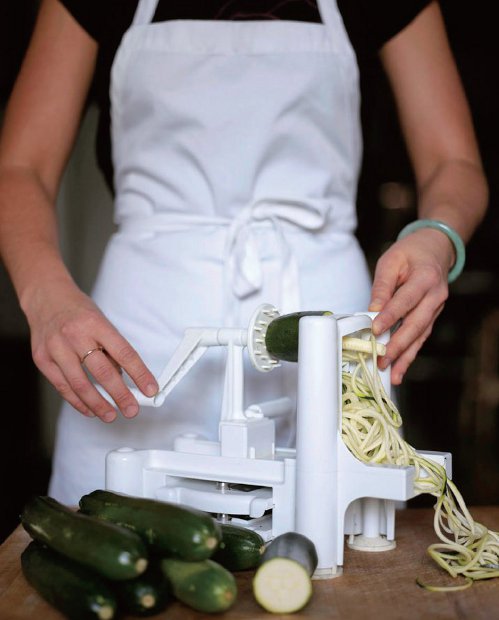
COOKING WHOLE GRAINS
Whole grains can have a place in this lifestyle. They have a very basic low-impact taste, so they can lend themselves to many different dishes and flavors. The grains with the lowest starch content and acidity are millet, quinoa, and buckwheat. These are preferable for anyone who is taking a yeast-conscious approach to meal preparations. Other very clean and delicious grains are all of the harvest grains, such as amaranth (a pseudograin), Kamut (a variety of khorasan wheat, an ancient grain), and spelt.
Grain is best consumed with raw or cooked vegetables and can also follow an avocado-based dish or salad. It should be well cooked or sprouted to ensure hydration for easy transit through the digestive system.
To make light and fluffy grains to accompany a stir-fry or your favorite salad or vegetable dish, or even to enjoy as a hot cereal, follow these steps:
1. In a pot, combine 1 part grain to 2 parts water or vegetable stock and bring to a boil on your stovetop. Turn down the heat to a simmer and cover. Let simmer until the water is almost gone (about 15−20 minutes, depending on the grain).
2. Remove from heat and let stand for 5 minutes or until the last bit of liquid is absorbed. Lightly fluff with a fork and serve hot, or let cool and then chill for a cold grain salad.
SPROUTING WHOLE GRAINS
Sprouting brings more alkalinity, water content, and life force to grains. If the process is too lengthy for you, you can certainly just enjoy low-starch grains cooked or soaked as you prefer. If you would like to try your hand at creating a truly raw grain dish, sprout away. For sprouting, choose organic unhulled grain, such as millet, quinoa, or buckwheat.
1. Carefully rinse the grain with cool, pure water by placing it in a glass or glass jar, filling it with water, covering it with a cheesecloth, then emptying the water out of the glass through the cheesecloth.
2. Refill the glass container with cool, pure water. Cover with plastic or foil and allow the grain to soak in a cool, dark place for 8−10 hours.
3. Drain the water and rinse the grain once again.
4. Spread the grain over a damp cheesecloth on a baking tray and cover with another damp cheesecloth.
5. Continue to rinse the grain morning and night until it begins to sprout (about 3 days). Rinse the grain one last time and place in a sealed container in the refrigerator.
NOTE: Sprouted grain should be eaten right away for freshness. It can be stored for up to 4 days if rinsed every 24 hours. Rancid or moldy grain will have a distinct smell and a slimy texture. Throw rancid grain out right away!
a note about millet
MILLET IS THE SMALLEST OF THE LOW-STARCH GRAINS, CLOSER TO THE SEED FAMILY. IT LEAVES AN ALKALINE ASH IN THE BODY AND HAS THE LOWEST ACIDITY OF ALL OF THE GRAINS. TO RELEASE ITS NUTTY FLAVOR, TOAST IT SLIGHTLY IN A HOT PAN BEFORE COOKING IN WATER.
